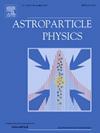超亮x射线源中贝特-希特勒对产生的影响
IF 2.9
3区 物理与天体物理
Q1 ASTRONOMY & ASTROPHYSICS
引用次数: 0
摘要
x射线双星中的一些黑洞吸积速度远远超过爱丁顿极限。在这种超临界状态下,光子被困在以辐射为主的几何厚度的圆盘中。最里面的区域形成了一个复杂的环境,有强烈的辐射、强磁场和强大的外流,在那里,辐射驱动的风驱逐了大量的物质。这些条件抑制了沿黑洞自转轴的透明漏斗内的初级相对论性电子。我们表明,高能电子可以从相对论性质子和环境光子之间的贝特-希特勒相互作用中以次级电子对的形式出现。利用具有超强x射线源(ULXs)强风的吸积盘的自相似模型,我们计算了通过磁重联和扩散冲击产生的粒子加速度,评估了能量损失,并评估了Bethe-Heitler对产生的效率和光谱痕迹。我们的研究结果表明,次级电子对可以产生0.1-100 MeV范围内的非热辐射,光度从1034到1038 erg s−1。这种发射可以被未来来自银河系ulx的MeV仪器探测到,提供了相对论性质子在其内部漏斗中存在的证据,并揭示了银河系中错位的、隐藏的超级爱丁顿源。本文章由计算机程序翻译,如有差异,请以英文原文为准。
Effects of Bethe–Heitler pair production in ultraluminous X-ray sources
Some black holes in X-ray binaries accrete at rates far above the Eddington limit. In this supercritical regime, photons are trapped in a radiation-dominated, geometrically thick disk. The innermost regions form a complex environment of intense radiation, strong magnetic fields, and powerful outflows, where radiation-driven winds expel large amounts of mass. These conditions suppress primary relativistic electrons within the transparent funnel along the black hole’s spin axis. We show that high-energy electrons can instead arise as secondary pairs from Bethe–Heitler interactions between relativistic protons and ambient photons. Using self-similar models of accretion disks with strong winds of ultraluminous X-ray sources (ULXs), we compute particle acceleration via magnetic reconnection and diffusive shocks, evaluate energy losses, and assess the efficiency and spectral imprint of Bethe–Heitler pair production. Our results suggest that secondary pairs can yield nonthermal radiation in the 0.1-100 MeV range with luminosities from up to erg s−1. This emission could be detectable by future MeV instruments from Galactic ULXs, offering evidence of relativistic protons in their inner funnels and revealing misaligned, otherwise hidden, super-Eddington sources in the Milky Way.
求助全文
通过发布文献求助,成功后即可免费获取论文全文。
去求助
来源期刊

Astroparticle Physics
地学天文-天文与天体物理
CiteScore
8.00
自引率
2.90%
发文量
41
审稿时长
79 days
期刊介绍:
Astroparticle Physics publishes experimental and theoretical research papers in the interacting fields of Cosmic Ray Physics, Astronomy and Astrophysics, Cosmology and Particle Physics focusing on new developments in the following areas: High-energy cosmic-ray physics and astrophysics; Particle cosmology; Particle astrophysics; Related astrophysics: supernova, AGN, cosmic abundances, dark matter etc.; Gravitational waves; High-energy, VHE and UHE gamma-ray astronomy; High- and low-energy neutrino astronomy; Instrumentation and detector developments related to the above-mentioned fields.
 求助内容:
求助内容: 应助结果提醒方式:
应助结果提醒方式:


